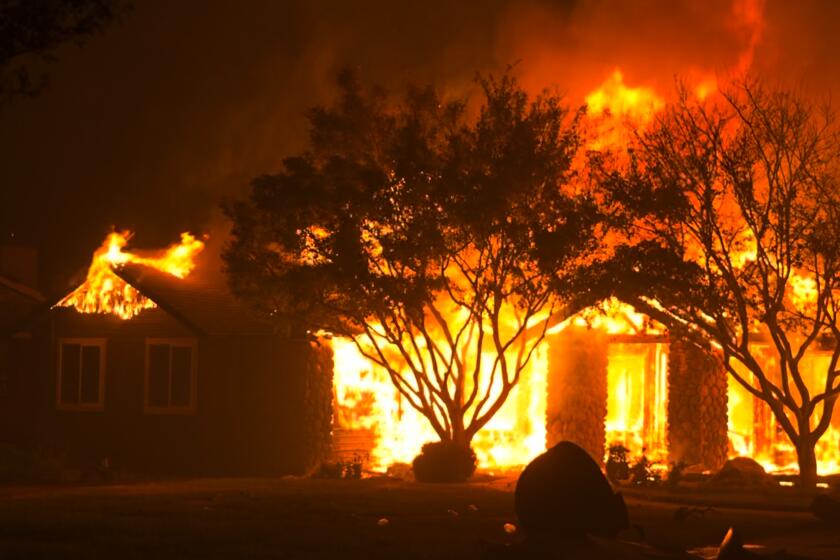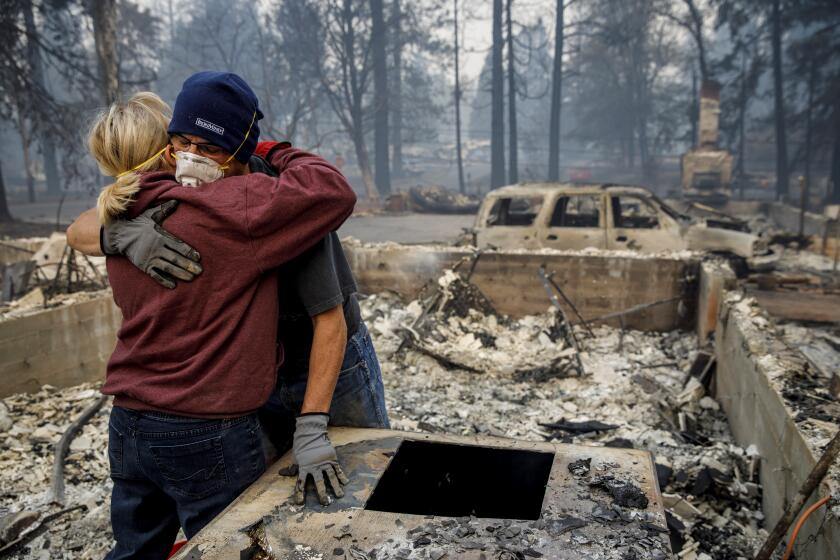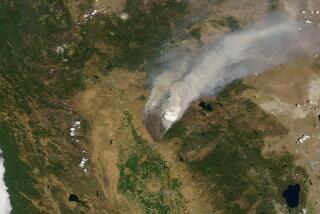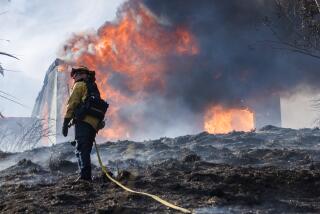The ‚Äėextraordinary‚Äô growth of California‚Äôs largest fire raises alarms. It could burn for months
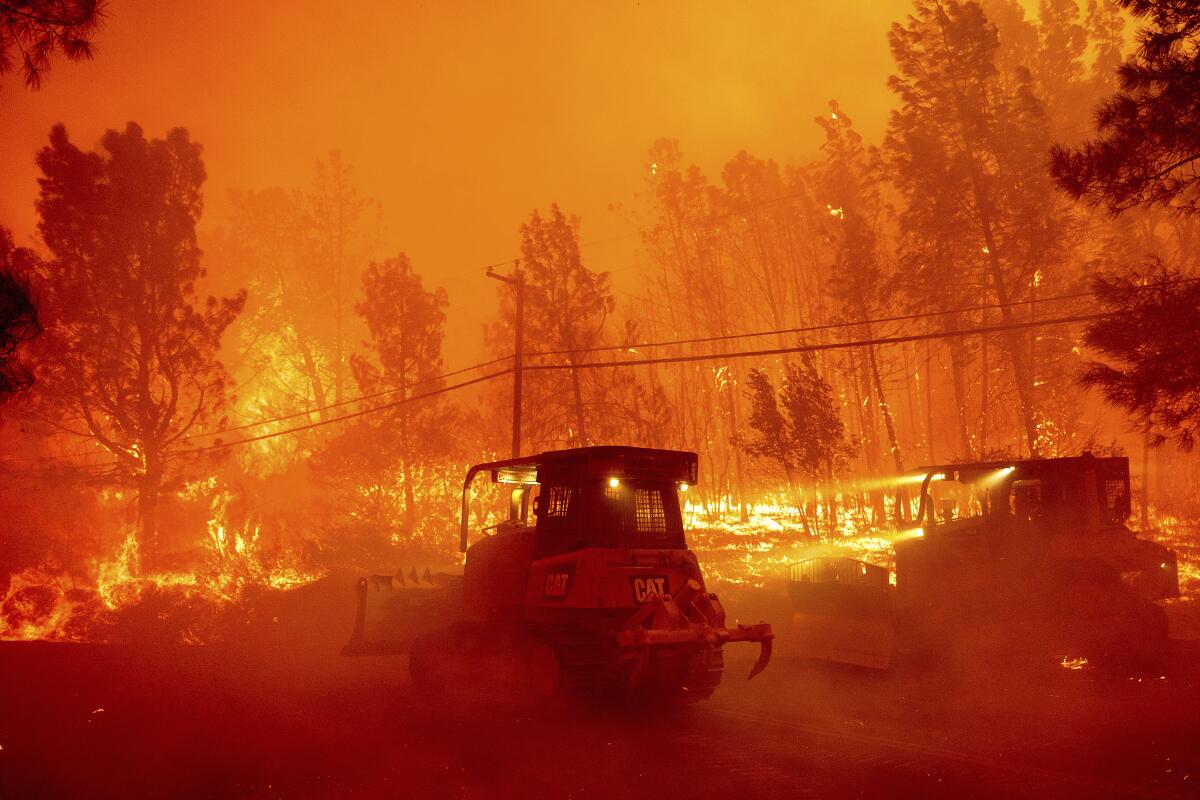
Just before 3 p.m. on Wednesday afternoon, as temperatures in Butte County simmered around 106 degrees, a man pushed a burning car down a gully in Chico in what authorities say was an act of arson.
Within minutes, the flaming vehicle ignited tall grasses that had sprung up in the wake of a wet winter but dried out in recent weeks. Soon, live oak trees and grapevine were burning, and wind-driven embers were shooting down canyons and the along ridges of the Lassen foothills, catching new vegetation as they touched down.
By nightfall, the Park fire had grown to 6,000 acres, and by the following morning its size had expanded sevenfold. As of Sunday, the fire had surpassed 353,000 acres ‚ÄĒ the largest so far this year in California ‚ÄĒ with no containment and few signs of slowing down.
Experts say the fire’s explosive growth is due to a perfect storm of hot, dry conditions, combustible vegetation and a landscape that hasn’t burned in decades. The remote terrain has made it challenging for crews to gain access to the blaze’s swelling perimeter, and the firefight could be long and arduous as they struggle to gain a foothold.
‚ÄúThis is really the first fire in the past several years in California that I would call extraordinary ‚ÄĒ and that‚Äôs not a good thing,‚ÄĚ Daniel Swain, a climate scientist with UCLA, said in a briefing. ‚ÄúThis fire is a big deal, and it has done some pretty incredible things.‚ÄĚ
Indeed, the fire and its massive smoke plume have already exhibited rare and erratic behavior, including ‚Äúsuper-cell thunderstorm-like characteristics‚ÄĚ replete with large-scale rotations, Swain said. On Thursday, footage captured by AlertCalifornia wildfire cameras appeared to show the blaze spewing tornado-like vortices, sometimes referred to as fire-whirls or firenados.
‚ÄúAt this point the fire is kind of creating its own weather, and that can be pretty unpredictable,‚ÄĚ said Courtney Carpenter, a meteorologist with the National Weather Service in Sacramento. ‚ÄúReally big, explosive wildfires can create thunderstorms; they can make whirling fire plumes that can mimic tornadoes.‚ÄĚ
The Park fire‚Äôs thunderstorm characteristics haven‚Äôt yet sparked lightning ‚ÄĒ though Carpenter said that‚Äôs still possible given its ‚Äúexplosive fire growth‚ÄĚ and extreme behaviors. She noted that smoke from the blaze has already reached Oregon.
Fortunately, the fire‚Äôs rapid rate of spread has so far marched it north and east ‚ÄĒ stretching across northern Butte County and a growing portion of Tehama County ‚ÄĒ into a relatively remote mixture of grass, brush and timber and away from the threatened communities of Cohasset and Forest Ranch. But Swain said it is almost certain to become several times larger than it currently is, and will probably be a several-hundred-thousand-acre fire before it is contained.
‚ÄúThis is a fire we‚Äôre going to have with us for weeks, if not months,‚ÄĚ he said. ‚ÄúThis may be one of those fires that starts in midsummer and burns into mid-autumn ... and it could end up posing more of a threat to communities later on.‚ÄĚ
A wildfire burning northeast of Chico has swelled to more than 164,000 acres, sending thousands of residents fleeing in the night.
The fire has already carved a path of destruction. Chief Garrett Sjolund, of the California Department of Forestry and Fire Protection‚Äôs Butte County unit, said ‚Äúnumerous structures‚ÄĚ have been burned, including 134 buildings destroyed and an additional 4,000 under threat.
Ignited within Chico‚Äôs city limits, the fire has had an overwhelming favorable path, experts said‚ÄĒ pushed by dry, southerly winds that moved it away from the city center.
However, officials have been worried about the community of Cohasset, where they initially feared a repeat of the 2018 Camp fire, which razed the nearby community of Paradise and killed 85 people ‚ÄĒ the deadliest wildfire on record in California. During that blaze, dozens of people were trapped on the area‚Äôs limited roadways while trying to escape.
‚ÄúCohasset was particularly concerning to us because ‚Ķ there is really only one way out and that is a narrow, windy road,‚ÄĚ said Butte County Sheriff Kory Honea. ‚ÄúIt is hard to traverse, so we wanted to get those warnings out as quickly as we could.‚ÄĚ
About 4,000 residents have been evacuated from Cohasset, Forest Ranch and parts of northeast Chico, along with several rural areas in southern Tehama County.
While the dry winds that drive fire weather conditions in the area typically come from the north, a less frequent pattern brought them from the south this week and sucked up all the Bay Area moisture they usually carry with them, said Carpenter, the weather service meteorologist.
‚ÄúThings have been really dry for the last month ‚ÄĒ and hot ‚ÄĒ and that‚Äôs why we‚Äôre seeing those critical fire conditions,‚ÄĚ she said.
The area was been under a red flag warning, signaling dangerous weather that supports rapid fire grow, both Thursday and Friday.
That pattern has pushed flames into wilderness that has been untouched by fire for decades, if not longer ‚ÄĒ making it ripe with thicker vegetation and dead and dying brush, which ignites easily and fast.
‚ÄúThere‚Äôs tremendous amounts of live and dead fuels,‚ÄĚ said Dan Collins, a spokesperson for Cal Fire‚Äôs Butte Unit. He added that the Ishi Wilderness area and some parts of Cohasset ‚Äúhave zero to little fire history‚ÄĚ on record.
The region’s rugged topography is hampering firefighting efforts, with steep cliffs, expansive canyons and few roadways throughout the national forest.
‚ÄúThat‚Äôs one of the big challenges, just getting folks [to the fire lines] due to the remote area,‚ÄĚ Collins said.
The Camp fire in Paradise revealed vulnerabilities in forest management, electrical equipment, city planning and evacuations. Has the state made strides against those shortcomings?
The blaze isn’t the only Western wildfire of concern. Cal Fire is battling more than 20 active fires in the state, while crews in Canada are combating an 89,000-acre blaze in the Alberta province that has already leveled portions of the historic resort town of Jasper. Experts say many of the fires have been fueled by the persistent, record-setting heat wave that has blanketed the West for weeks.
Residents from the Chico area are watching the Park fire’s movements with anxiety.
‚ÄúIt‚Äôs been a pretty restless time for us,‚ÄĚ said Don Hankins, a professor of geography and planning at Cal State Chico who is also on the Butte County Fire Safe Council.
The Big Chico Creek Ecological Reserve where he conducts much of his research has already burned, with cameras indicating that nearly all of its infrastructure has been lost, including an 1870s-era barn, Hankins said.
Though the blaze has some echoes of the Camp fire, the community of Cohasset has prepared in recent years for a potential fire, Hankins said, including fuel-reduction projects and prescribed burns to help clear some of the combustible material that lies between the town and the wildland.
‚ÄúBut unfortunately, with the wind on this, and the scale of these projects, it‚Äôs not necessarily enough to make a difference‚ÄĚ if the fire continues to burn out of control, he said.
The days and weeks ahead are likely to see more acreage added to the fire as crews contend with rugged, volcanic topography and persistent hot and dry conditions.
‚ÄúThe outlook is that it‚Äôs not going to be easily contained,‚ÄĚ Hankins said. ‚ÄúWe‚Äôve got a long season ahead of us before the rainy season comes, and that‚Äôs really going to be the ultimate thing to curtail any of these fires that are happening across the West right now.‚ÄĚ
Sjolund, the fire chief in Butte County, said he‚Äôs hopeful an expected drop in temperatures and increase in humidity this weekend could assist in fighting the Park fire ‚ÄĒ and others across the region.
‚ÄúIt‚Äôs kind of a moving target with the way the weather patterns are coming in,‚ÄĚ he said. ‚ÄúThis fire is moving very rapidly and very quickly.‚ÄĚ
More to Read
Sign up for Essential California
The most important California stories and recommendations in your inbox every morning.
You may occasionally receive promotional content from the Los Angeles Times.
